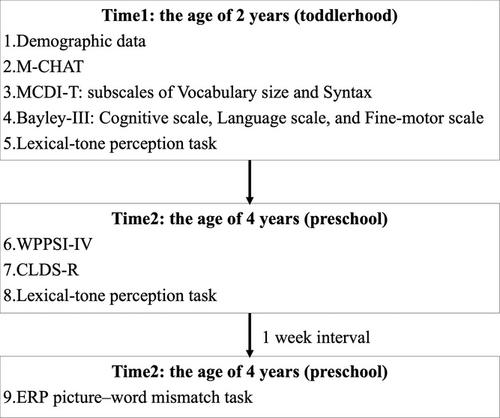Event-related potentials of familiar monosyllabic words with unexpected lexical tones: A picture-word study of Mandarin-speaking preschoolers with and without a history of late talking
Abstract
This study examined how Mandarin-speaking preschoolers with and without a history of late talking (LT) process familiar monosyllabic words with unexpected lexical tones, focusing on both phonological and semantic violations. This study initially enrolled 64 Mandarin-speaking toddlers: 31 with a history of LT (mean age: 27.67 months) and 33 without a history of LT (non-LT) (mean age: 27.85 months). Event-related potentials were recorded at the age of 4 years during a picture-word mismatch task (LT mean age: 51.36 months; non-LT mean age: 51.20 months); in this task, the participants were presented with auditory words either matching (Tone 3) or mismatching with images in terms of their lexical tones; the mismatches encompassed acoustically dissimilar (Tone 1) and similar (Tone 2) mismatches. A significant difference in the phonological mapping negativity (PMN) responses to Tones 1 and 3 was observed only in the non-LT group. However, differences in the N400 responses to Tones 1 and 3 remained consistent across both groups. In addition, greater differences in the PMN responses between Tones 1 and 3 were associated with higher language proficiency during the preschool period. The PMN response serves as an indicator of neural correlates in lexical tone processing, reflecting challenges encountered by preschoolers with a history of LT when processing the lexical tones of familiar words. Furthermore, the PMN response was correlated with concurrent language abilities. These findings indicate the importance of early tonal perception development for Mandarin speakers with a history of LT.
Research Highlights
- Preschoolers with a history of late talking (LT), similar to preschoolers without such a history, can establish word expectations and detect the lexical tone violation in real time. However, those with a history of LT require additional time to process acoustic cues and differentiate between word semantics based on lexical tone information.
- The phonological mapping negativity response serves as an indicator of neural correlates in lexical tone processing, reflecting challenges encountered by preschoolers with a history of LT when processing the lexical tones of familiar words.
- The present findings indicate the importance of early intervention for Mandarin speakers with a history of LT, with an emphasis on lexical tone processing from toddlerhood.


 求助内容:
求助内容: 应助结果提醒方式:
应助结果提醒方式:


